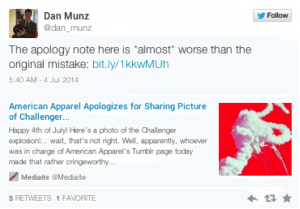
On October 4, 1957, the Soviet Union pulled ahead of the United States in the infamous “Space Race” by launching Sputnik 1 (satellite) into lower Earth orbit. Over a decade later, the United States became the first country to land a man on the moon, thus ending the Space Race. Many shuttle launches have taken place since that iconic day, however, none were as shocking to the American public as the Challenger Disaster on January 28, 1986.
Just a minute after the initial launch, an O-Ring in the rocket’s right booster failed, causing the rocket to explode in front of shocked audiences. All seven crew members of Challenger, including a teacher, were killed instantly in the inferno. This was the first major shuttle tragedy experienced in the United States. Not only were people horrified by the deaths broadcasted on live television, but this event also proved how deadly these missions can be. So what does this have to do with marketing?
On July 3rd, 2014, American Apparel posted a picture of the challenger aftermath with a red background and the text, “On this July 4th, @americanapparel interprets ‘rockets red glare’ literally, with a pic of the Challenger explosion.” This clear misuse of the term “rockets red glare” is only overshadowed by the use of a national tragedy to gain more exposure. American Apparel pulled down the Tumblr post, but not before readers discovered it.
American Apparel then posted an apology saying:
We deeply apologize for today’s Tumblr post of the Space Shuttle Challenger. The image was re-blogged in error by one of our international social media employees who was born after the tragedy and unaware of the event. We sincerely regret the intensity of that selection and the post has been deleted.
Although they released an apology, many angered readers were quick to post their dissatisfaction with the original post and the apology. The anger towards the original post seems generally accepted by all parties. However, there are mixed reactions on the heat spawned from the apology. Public apologies released by large brands are generally used to combat bad publicity with a sincere, or sincere sounding, acknowledgement of a wrong doing, with promises of fixing the situation. American Apparel did mention that the post was previously deleted in attempt to rectify the situation, but to no avail. One angry poster replied by saying, “The excuse: Their social media mgr was born after the Challenger disaster. That’s lame.” Another poster went as far as to say, “The apology not here is *almost* worse than the original mistake.”

Let’s take a deeper look into the apology. American Apparel claimed that the image was posted by an international employee born after the tragedy. Instead of just apologizing, they attempted to sway audiences by displaying the forgivable ignorance of the poster because of his or her age. They also mentioned that the poster was an international employee. This attempt clearly backfired on the company because audiences did not buy it. In fact, this remark just seemed to make matters worse for American Apparel.
Why did the apology backfire?
The apology seemed to lack sincerity for one simple reason. They attempted to lessen the blow by offering an excuse to the general public. Instead of accepting full responsibility for the mishap, they tried to transfer the blame to a single employee in an attempt to disassociate with their error.
What does this mean for brands?
Lesson to be learned: Review all marketing materials before they are released to the general public. Once the content is posted, you cannot control how people react, how the backlash will affect your brand equity, or where the media will spread after release. The Tumblr post should have been reviewed by the employee’s superior before submission. Especially if the post deals with something that could be considered offensive or of bad taste. Audiences clearly do not care how old a company representative is, and with good reason. Marketers need to play Devil’s advocate with all marketing actions to ensure accuracy, legitimacy, and professionalism of all created materials. Posting or reposting information without careful research is careless and often causes problems like this to occur.
Social Media engagement is a fickle art combined with a good dose of science. Companies find themselves walking the fine line of creating socially engaging content that is not offensive to the multiple demographics that may be viewing the post. American Apparel’s snafu is an example of how one misstep can cause serious damage to brand equity. Although Social media is an ongoing labor of love/hate, each post made by a company is important and the messages need to be designed as such. All the more reason to trust marketing agencies to control and maintain your Social engagement, rather than a 20-something in the office that knows how to post to Social platforms but fails to understand the implications of poor Social Media interactions.








